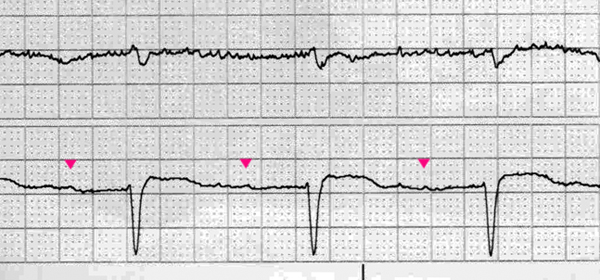sinus bradycardia
First Glance:
From across the room it looks a regular narrow-complex borderline bradycardia.
Discussion:
The regular QRS’s are narrow, at a rate of ~55 bpm. At first glance, it looks like a fibrillatory baseline as there are no obvious P waves. On second glance, I wondered whether some of the small positive deflections in the lower lead might be P waves, but they weren’t consistent across the strip and I figured this could be a junctional rhythm. This would fit well, after all. The rate is consistent with a junctional escape rhythm, and the QRS’s were narrow and regular.
For full value, I took a look at the last 12L. It had a pristine baseline and clearly had regular tiny positive P waves in the septal leads with a PR interval of 352ms (calculated by the machine). And here we are, with those same tiny deflections in our monitor strip:

However, the rate was significantly faster in the 12L. This makes me wonder if the bradycardia is due to a 2:1 block. This patient already has evidence of AV disease (1st degree block). If they were having a second degree block the tiny blocked P might well be hidden in that ST complex.
There is slight ST elevation in the chest lead at 50% gain.
Final Impression?
Sinus bradycardia with first degree block @ ~55 bpm, suspicious for possible ischemia. Can’t rule out atrial rate of 110 bpm with AV block.
Management implications:
Both junctional and sinus bradycardias are likely to respond to atropine while stabilizing a hemodynamically compromised patient, even with a first degree block or a 2nd degree type I. The same is not so true for higher blocks.
A pristine 12L would evaluate for ischemia, and with increased gain might evaluate for possible P waves superimposed on the ST complexes.
The Take-home Point:
Finding the P waves is key. Increasing the gain on the chest lead would have likely revealed the regular P waves before the QRS’s, and maybe during the ST complex as well. Even if the gain is too high to see the whole QRS complex on one screen, that is not of significance. The QRS is interesting on the monitor if it is widening, but that can be seen even if you don’t see the top and bottom of the complex. More likely to be interesting on the monitor is the rhythm, and it is difficult to be definitive about that without seeing atrial activity.
![]() Two star strip. The meat and potatoes.
Two star strip. The meat and potatoes.
